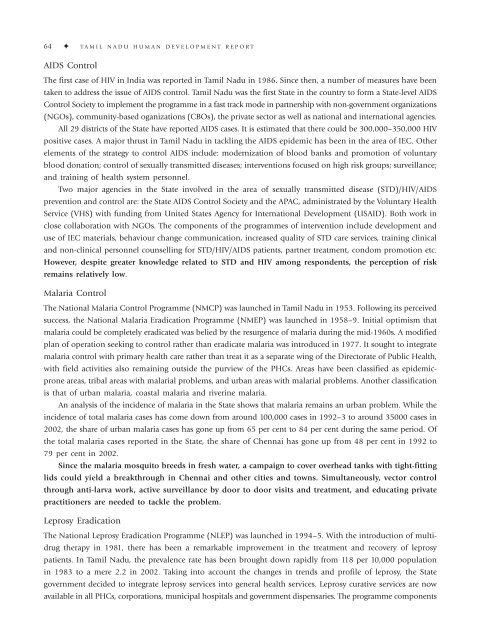Tamil Nadu 2003 - of Planning Commission
Tamil Nadu 2003 - of Planning Commission
Tamil Nadu 2003 - of Planning Commission
You also want an ePaper? Increase the reach of your titles
YUMPU automatically turns print PDFs into web optimized ePapers that Google loves.
64 ✦ T AMIL NADU HUMAN DEVELOPMENT REPORT<br />
AIDS Control<br />
The first case <strong>of</strong> HIV in India was reported in <strong>Tamil</strong> <strong>Nadu</strong> in 1986. Since then, a number <strong>of</strong> measures have been<br />
taken to address the issue <strong>of</strong> AIDS control. <strong>Tamil</strong> <strong>Nadu</strong> was the first State in the country to form a State-level AIDS<br />
Control Society to implement the programme in a fast track mode in partnership with non-government organizations<br />
(NGOs), community-based oganizations (CBOs), the private sector as well as national and international agencies.<br />
All 29 districts <strong>of</strong> the State have reported AIDS cases. It is estimated that there could be 300,000–350,000 HIV<br />
positive cases. A major thrust in <strong>Tamil</strong> <strong>Nadu</strong> in tackling the AIDS epidemic has been in the area <strong>of</strong> IEC. Other<br />
elements <strong>of</strong> the strategy to control AIDS include: modernization <strong>of</strong> blood banks and promotion <strong>of</strong> voluntary<br />
blood donation; control <strong>of</strong> sexually transmitted diseases; interventions focused on high risk groups; surveillance;<br />
and training <strong>of</strong> health system personnel.<br />
Two major agencies in the State involved in the area <strong>of</strong> sexually transmitted disease (STD)/HIV/AIDS<br />
prevention and control are: the State AIDS Control Society and the APAC, administrated by the Voluntary Health<br />
Service (VHS) with funding from United States Agency for International Development (USAID). Both work in<br />
close collaboration with NGOs. The components <strong>of</strong> the programmes <strong>of</strong> intervention include development and<br />
use <strong>of</strong> IEC materials, behaviour change communication, increased quality <strong>of</strong> STD care services, training clinical<br />
and non-clinical personnel counselling for STD/HIV/AIDS patients, partner treatment, condom promotion etc.<br />
However, despite greater knowledge related to STD and HIV among respondents, the perception <strong>of</strong> risk<br />
remains relatively low.<br />
Malaria Control<br />
The National Malaria Control Programme (NMCP) was launched in <strong>Tamil</strong> <strong>Nadu</strong> in 1953. Following its perceived<br />
success, the National Malaria Eradication Programme (NMEP) was launched in 1958–9. Initial optimism that<br />
malaria could be completely eradicated was belied by the resurgence <strong>of</strong> malaria during the mid-1960s. A modified<br />
plan <strong>of</strong> operation seeking to control rather than eradicate malaria was introduced in 1977. It sought to integrate<br />
malaria control with primary health care rather than treat it as a separate wing <strong>of</strong> the Directorate <strong>of</strong> Public Health,<br />
with field activities also remaining outside the purview <strong>of</strong> the PHCs. Areas have been classified as epidemicprone<br />
areas, tribal areas with malarial problems, and urban areas with malarial problems. Another classification<br />
is that <strong>of</strong> urban malaria, coastal malaria and riverine malaria.<br />
An analysis <strong>of</strong> the incidence <strong>of</strong> malaria in the State shows that malaria remains an urban problem. While the<br />
incidence <strong>of</strong> total malaria cases has come down from around 100,000 cases in 1992–3 to around 35000 cases in<br />
2002, the share <strong>of</strong> urban malaria cases has gone up from 65 per cent to 84 per cent during the same period. Of<br />
the total malaria cases reported in the State, the share <strong>of</strong> Chennai has gone up from 48 per cent in 1992 to<br />
79 per cent in 2002.<br />
Since the malaria mosquito breeds in fresh water, a campaign to cover overhead tanks with tight-fitting<br />
lids could yield a breakthrough in Chennai and other cities and towns. Simultaneously, vector control<br />
through anti-larva work, active surveillance by door to door visits and treatment, and educating private<br />
practitioners are needed to tackle the problem.<br />
Leprosy Eradication<br />
The National Leprosy Eradication Programme (NLEP) was launched in 1994–5. With the introduction <strong>of</strong> multidrug<br />
therapy in 1981, there has been a remarkable improvement in the treatment and recovery <strong>of</strong> leprosy<br />
patients. In <strong>Tamil</strong> <strong>Nadu</strong>, the prevalence rate has been brought down rapidly from 118 per 10,000 population<br />
in 1983 to a mere 2.2 in 2002. Taking into account the changes in trends and pr<strong>of</strong>ile <strong>of</strong> leprosy, the State<br />
government decided to integrate leprosy services into general health services. Leprosy curative services are now<br />
available in all PHCs, corporations, municipal hospitals and government dispensaries. The programme components

















